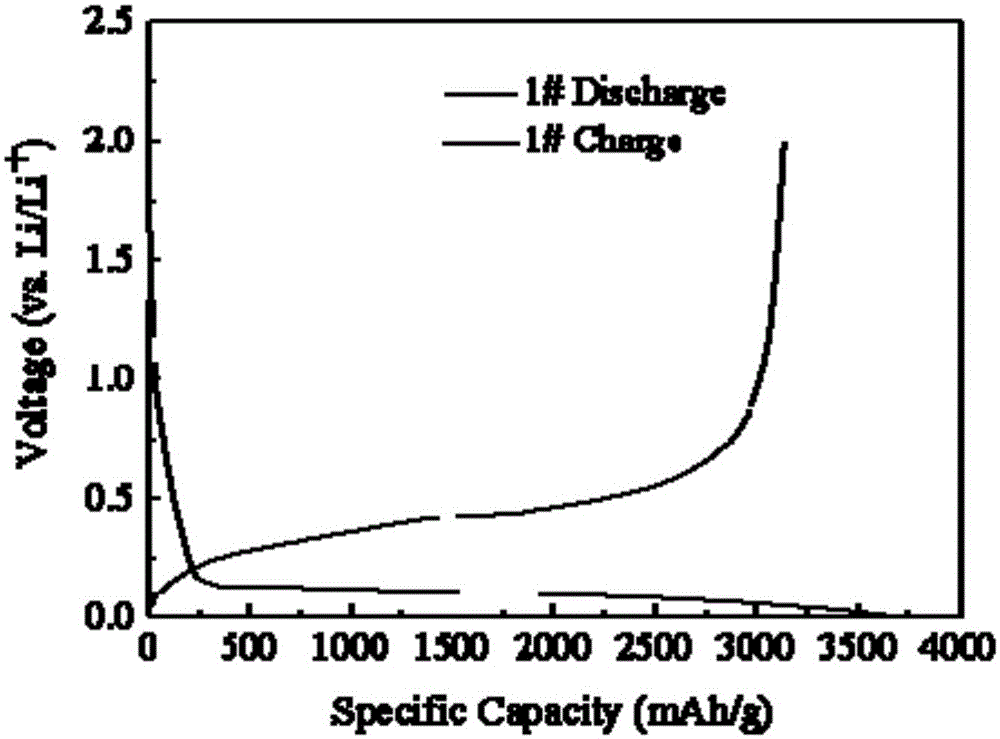Silicon carbon composite material and preparation method thereof
A technology of silicon-carbon composite materials and carbon layers, which is applied in the direction of nanotechnology, electrical components, electrochemical generators, etc. for materials and surface science, can solve the problems of difficulty in practical application, consumption, and high preparation costs, and achieve improved capacity Effects of performance and cycle life, increased contact area, and high electrochemical capacity
- Summary
- Abstract
- Description
- Claims
- Application Information
AI Technical Summary
Problems solved by technology
Method used
Image
Examples
preparation example Construction
[0022] In a second aspect, the present invention provides a method for preparing a silicon-carbon composite material, comprising the following steps:
[0023] A. Mix nano-silica powder with the aqueous turbid solution of carbon source to form a uniform suspension;
[0024] B. The suspension obtained in step A is subjected to spray cracking at 200-700° C. by spray-drying method, and the solvent is removed to obtain a crude product of Si-C composite material, which is then pyrolyzed at 500-900° C. in an inert gas atmosphere. Prepared Si-C porous core-shell composite nanomaterials;
[0025] C. Mix the Si-C porous core-shell composite nanomaterial obtained in step B with a surfactant evenly, add a conductive polymer and an initiator in turn, react at 0-30°C for 4-12 hours, wash and dry to obtain three layers Core-shell structure silicon-carbon composites.
[0026] Preferably, step D is also included. The three-layer core-shell structure silicon-carbon composite material prepared...
Embodiment 1
[0033] First, add 0.10 g of nano-silicon powder particles with a particle size of 100 nm into an aqueous solution of glucose with a concentration of 0.50 M, and ultrasonically disperse for 30 minutes to form a uniform suspension;
[0034] Secondly, the suspension obtained above was sprayed and cracked at 200°C by spray drying method, and then pyrolyzed at 700°C in an inert gas atmosphere to prepare Si-C porous core-shell composite nanomaterials;
[0035] Then, 0.13 g of the above Si-C porous core-shell composite nanomaterial was added to 200 mL of 0.20 mol L -1 In an aqueous solution of cetyltrimethylammonium bromide, ultrasonically disperse for 90 minutes to form a uniform suspension, and then distill 100mL of freshly distilled concentration to 0.40mol L -1 The polypyrrole solution was added dropwise to the suspension, ultrasonicated for 45min, and 20mL of 1.00mol L was slowly added dropwise under stirring. -1 FeCl 3solution, stirred at 5°C for 12 hours, washed with water a...
Embodiment 2
[0038] First, add 0.10 g of nano-silicon powder particles with a particle size of 50 nm into an aqueous solution of maleic acid with a concentration of 0.50 M, and ultrasonically disperse for 30 minutes to form a uniform suspension;
[0039] Secondly, the suspension obtained above is sprayed and cracked at 500°C by spray drying method, and then pyrolyzed at 900°C in an inert gas atmosphere to prepare Si-C porous core-shell composite nanomaterials;
[0040] Then, 0.13 g of the above Si-C porous core-shell composite nanomaterial was added to 200 mL of 1mol L -1 In the aqueous solution of sodium dodecylbenzenesulfonate, ultrasonically disperse for 90min to form a uniform suspension, then distill 100mL freshly to a concentration of 0.20mol L -1 The polypyrrole solution was added dropwise to the suspension, ultrasonicated for 45min, and 20mL of 0.50mol L was slowly added dropwise under stirring. -1 (NH 4 ) 2 S 2 o 8 solution, stirred at 5°C for 12 hours, washed with water and ...
PUM
| Property | Measurement | Unit |
|---|---|---|
| Particle size | aaaaa | aaaaa |
| Carbon layer thickness | aaaaa | aaaaa |
| Thickness | aaaaa | aaaaa |
Abstract
Description
Claims
Application Information
 Login to View More
Login to View More - R&D
- Intellectual Property
- Life Sciences
- Materials
- Tech Scout
- Unparalleled Data Quality
- Higher Quality Content
- 60% Fewer Hallucinations
Browse by: Latest US Patents, China's latest patents, Technical Efficacy Thesaurus, Application Domain, Technology Topic, Popular Technical Reports.
© 2025 PatSnap. All rights reserved.Legal|Privacy policy|Modern Slavery Act Transparency Statement|Sitemap|About US| Contact US: help@patsnap.com


